SGC SG-211 Operating Manual
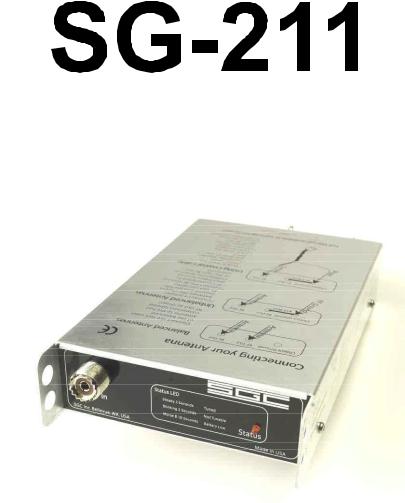
The Zero Power Smartuner
Catalog Number 54-26
April 2004

Thank you for buying your new SG211 Antenna Coupler. The SG-211 incorporates the very latest American-made technology as well as our experience in having delivered more than 100,000 Smartuners since 1985. It is a state-of-the-art tuner providing a new and unique level of usefulness.
The concept of the SG-211 is quite different from the rest of our line of Smartuners. It is a unique departure designed to provide flexible matching capabilities in a portable environment where power is at a premium. The ease of installation and flexible operation make this an ideal choice when power is limited. We know that the simplicity, reliability, and flexibility of the SG-211 will enhance your HF operation for years to come.
SGC continues to focus on providing the most useful products and services for our customers around the world.
Please feel free to call to discuss your antenna system requirements at any time. We look forward to making your HF experience the very best.
Pamela Goral
President
Pierre Goral
Founder 1936-2004
Mailing: PO Box 3526, Bellevue, WA. 98009
Shipping: 13737 SE 26th St. Bellevue, WA. 98005
Toll Free: 800-259-7331 * Phone: 425-746-6310 * Fax: 425-746-6384 www.sgcworld.com * Email: sgc@sgcworld.com

SG-211 User’s Manual
Warnings
IMPORTANT NOTE: A random antenna wire will radiate RF. Not only is this an RF Hazard within the station, but it can cause local interference both within the station and in the vicinity depending on your power level.
CAUTION: Unbalanced antennas are radiating from the line as soon as they leave the SG-211. Minimize the amount of wire inside the radio room to prevent interference with electronic equipment. Minimizing power will also minimize interference caused by this kind of antenna.
© 2004 SGC Inc. |
Page 1 |
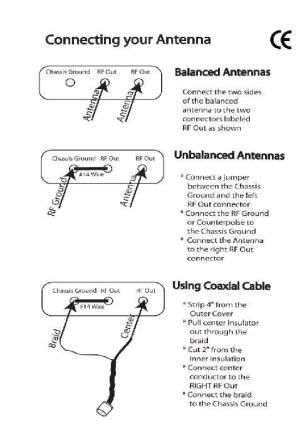
SG-211 User’s Manual
Quick Start/Reference
© 2004 SGC Inc. |
Page 2 |
SG-211 User’s Manual
Table of Contents
1 |
INTRODUCTION ................................................ |
5 |
|
|
1.1 |
SPECIFICATIONS............................................. |
5 |
|
1.2 |
MECHANICAL DESIGN ................................... |
7 |
2 |
SG-211 SETUP ..................................................... |
8 |
|
|
2.1 |
CONNECTIONS TO THE SG-211 ...................... |
8 |
|
2.1.1 RF Input from your transceiver................ |
8 |
|
|
2.1.2 Antenna and RF Ground Connections ..... |
9 |
|
|
2.2 |
BATTERY REPLACEMENT............................. |
11 |
3 ANTENNAS AND THE SG-211 ....................... |
13 |
||
|
3.1 |
OPTIMUM COUPLING ................................... |
13 |
|
3.2 |
CONNECTING ANTENNAS............................. |
13 |
|
3.3 |
BALANCED VS. UNBALANCED ANTENNAS... |
15 |
|
3.4 |
ANTENNA RECOMMENDATIONS................... |
16 |
|
3.4.1 |
Dipoles ................................................... |
16 |
|
3.4.2 The Inverted V Antenna.......................... |
17 |
|
|
3.4.3 Dipoles with Matching Lines ................. |
17 |
|
|
3.4.4 Long Wires & Inverted Ls ...................... |
18 |
|
|
3.4.5 |
Vertical Antennas................................... |
20 |
|
3.4.6 |
Loops...................................................... |
23 |
|
3.4.7 |
Portable Antennas.................................. |
24 |
|
3.4.8 |
Beams..................................................... |
27 |
|
3.5 |
TIPS & TRICKS............................................. |
27 |
|
3.6 |
REFERENCES ON ANTENNAS ........................ |
29 |
|
3.6.1 |
From SGC .............................................. |
29 |
|
3.6.2 |
Books...................................................... |
29 |
3.7THE GOLDEN RULES OF HF INSTALLATION. 30
3.8 |
DO-IT-YOURSELF LIGHT BULB TEST |
........... 31 |
4 THEORY OF OPERATION ............................. |
35 |
|
4.1 |
NO EXTERNAL POWER REQUIRED ............... |
35 |
|
© 2004 SGC Inc. |
Page 3 |
SG-211 User’s Manual
|
4.2 |
THE MATCHING NETWORK.......................... |
36 |
|
4.3 |
THE SENSOR ................................................ |
37 |
|
4.4 |
THE RELAY DRIVER MATRIX ...................... |
38 |
|
4.5 |
MICROPROCESSOR ....................................... |
39 |
5 |
COMPONENT LOCATION ............................. |
41 |
|
6 |
SCHEMATICS ................................................... |
43 |
|
7 |
STANDARD WARRANTY ............................... |
48 |
|
© 2004 SGC Inc. |
Page 4 |
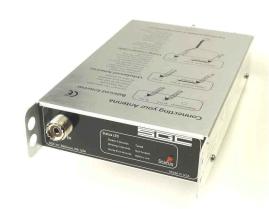
SG-211 User’s Manual
1 Introduction
1.1 Specifications
The SG-211 is a revolution. You’ve never seen a coupler so light weight or so flexible. Never has there been one so easy to carry and use. And NEVER have you seen one that will tune for 5 years on a single set of AA cells!
© 2004 SGC Inc. |
Page 5 |
SG-211 User’s Manual
HF Frequency Range: |
1.8-60 MHz |
|
Power Input Range: |
60 watts (PEP) 30 watts key-down |
|
(approximate) |
30 watts (PEP) with short antennas below |
|
|
3.5 Mhz |
|
|
20 watts data continuous operation |
|
Minimum Sensitivity |
Approximately 1 watt |
|
Memory bins: |
256 |
|
Input Impedance Range: |
.3-6000 ohms |
|
VSWR: |
Typically less than 2:1 |
|
DC Input Requirement: |
None (internal battery) |
|
Input Current: |
Zero |
|
Random set time: |
Average 4 seconds |
|
Recurrent set time: |
Typically less than 500 milliseconds |
|
Antenna Length: |
25 foot wire or whip from 1.8-60 Mhz |
|
|
8 foot wire or whip from 3.5-60 Mhz |
|
Installation: |
Any position |
|
Operating Temperature: |
-30° to +60°C |
|
Size: |
8.66 inches X 4.69 inches X 1.55 inches |
|
Weight: |
1 lb |
|
Case Construction: |
Irridited Aluminum |
|
Antenna types: |
1. |
Whip |
|
2. |
Backstay (marine, sail) |
|
3. |
Dipole centerfed |
|
4. |
Dipole with feedline |
|
5. |
Loop (small) 2x2 multi turn |
|
6. |
Loop (large) 10 ft. and up single turn |
|
7. |
Longwire |
|
8. |
Ladder feed |
|
9. |
Coaxial Fed Antennas |
Power Source |
4 AA Batteries lasting 5 years |
|
Front Panel Connections |
SO-239 RF Input Connector |
|
Rear Panel Connections |
Balanced and Unbalanced Wing Nuts |
|
Indicators |
1 Red LED on Front Panel: |
|
|
Steady for 2 seconds for tuned |
|
|
Blinking for 2 seconds for not tunable |
|
|
Morse B for 10 seconds for battery low |
|
© 2004 SGC Inc. |
Page 6 |
SG-211 User’s Manual
1.2 Mechanical Design
The SG-211 is in an Irridited Aluminum case. The RF input connector is an SO-239 on the front of the case. RF Output is from balanced and unbalanced connectors on the back. Internal construction makes the SG-211 suitable for portable or fixed location use. Corrosionresistant hardware and passive alloys are used throughout.
© 2004 SGC Inc. |
Page 7 |
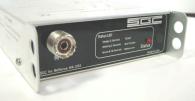
SG-211 User’s Manual
2 SG-211 Setup
Setup on the SG-211 is so easy there is almost nothing to do. It comes with AA batteries already installed. All you need to do is connect the coax from your transceiver, attach your antenna to the terminals on the back, and the SG-211 is ready to go.
2.1 Connections to the SG-211
2.1.1 RF Input from your transceiver
RF input to the SG-211 is through a standard SO-239 connector on the front. Choose good quality coaxial cable with a PL-259 connector. You may want to add a Power/SWR meter between the transceiver and the SG211 to monitor conditions. We recommend that you select one that measures Forward and Reverse power as well as SWR. This will provide more useful information about conditions on the line.
© 2004 SGC Inc. |
Page 8 |
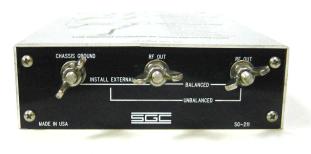
SG-211 User’s Manual
2.1.2Antenna and RF Ground Connections
A wide variety of antennas can be connected to the SG211. A set of wing nuts for connecting balanced or unbalanced antennas is provided on the back.
Optimum use of the SG-211 Smartuner is to put it directly at the antenna feed point. This may require enclosing it in a waterproof enclosure to protect it from the weather.
Either a balanced or an unbalanced antenna can be connected directly to the wing nuts provided on the back of the coupler.
If the Smartuner must be away from the antenna feed point, it is best to connect to the antenna with balanced feed line. The feed line can be connected to the balanced terminals on the back of the coupler. When it is not possible to use balanced feedline, then the antenna may be connected with coax.
© 2004 SGC Inc. |
Page 9 |

SG-211 User’s Manual
When feeding an unbalanced antenna directly, the RF Ground lug is connected with a jumper strap to one side of the balanced feed and the other side of the balanced feed is used for RF Hot.
If you are feeding your antenna with coaxial cable, then the cable is connected to the back panel by connecting the center conductor to the right RF Out connection and the braid to the Chassis Ground with a jumper to the left RF Out connection as shown below.
© 2004 SGC Inc. |
Page 10 |
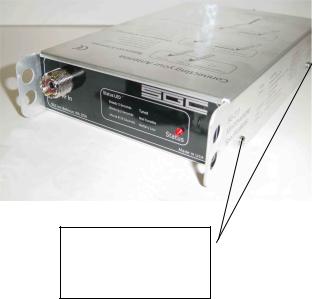
SG-211 User’s Manual
A short pigtail connector with an SO-239 female connector on it will make it easier to use Coaxial cable with the SG-211.
2.2 Battery Replacement
To replace the batteries inside the SG-211, you must unscrew the cover and remove it. The screws are on the left and right sides of the SG-211 as shown below.
Two Cover Screws on each side, none on front and back
The batteries are in two battery holders on the SG-211 circuit board. Any suitable alkaline AA batteries may be
© 2004 SGC Inc. |
Page 11 |
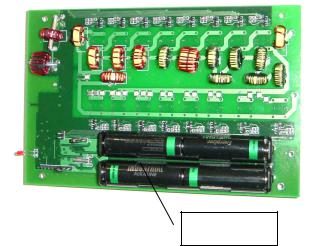
SG-211 User’s Manual
used. We recommend using the highest quality alkaline AA batteries available to assure the longest life with no battery leakage that could damage the circuit board.
Batteries
© 2004 SGC Inc. |
Page 12 |
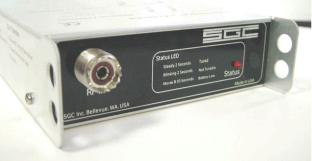
SG-211 User’s Manual
3 Antennas and the SG-211
The SG-211 can accommodate a wide variety of antennas.
3.1 Optimum Coupling
Optimum use of the SG-211 is to place it at the antenna feed point. This keeps SWR on the feed line to an absolute minimum.
3.2 Connecting Antennas
The SG-211 is provided with an SO-239 connector on the front panel for RF in. It has balanced and unbalanced connections on the back panel.
© 2004 SGC Inc. |
Page 13 |
